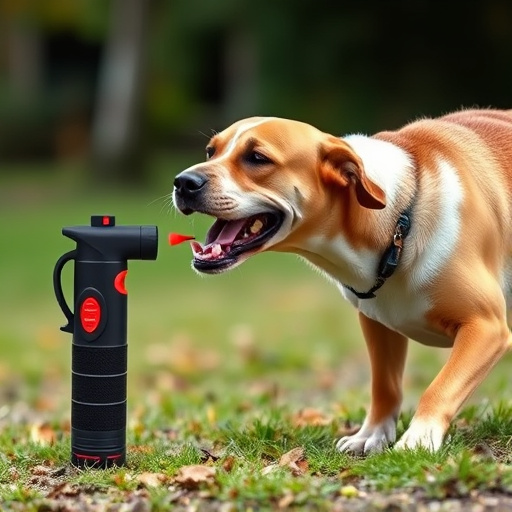This text provides guidance on using dog repellent sprays (containing capsaicin or picaridin) for keeping canines away, emphasizing responsible handling and adherence to safety guidelines. It outlines key mace spray techniques, including aiming low, quick bursts, and observation, for effective training in controlled environments. Regular practice strengthens dogs' understanding of appropriate conduct. Responsible use, combined with training and preventive measures, is crucial for managing dog-human interactions in various settings, as detailed in the guide "How to Practice Mace Spray Techniques."
“Unleash your outdoor freedom with our comprehensive guide to Dog Repellent Maximum Strength Spray. Discover the science behind these powerful tools, understanding key ingredients and safety measures. Learn effective mace spray techniques for both training and deterrence—from controlled bursts for positive reinforcement to strategic applications for unwelcome four-legged visitors. Explore responsible use tips for maximum effectiveness while avoiding harm. Master how to practice mace spray techniques with precision and responsibility.”
- Understanding Dog Repellent Spray: Ingredients and Safety
- Effective Mace Spray Techniques for Training and Deterrence
- Responsible Use: Tips for Maximum Effectiveness and Avoiding Harm
Understanding Dog Repellent Spray: Ingredients and Safety
Dog repellent spray is a popular choice for keeping canines at bay, whether it’s in your backyard, on a hiking trail, or even around your livestock. Understanding what makes up this potent tool is key to effective and safe use. These sprays typically contain active ingredients like capsaicin (derived from chili peppers) or picaridin, which trigger a sensation of irritation or discomfort when sprayed onto the skin or fur of a dog, encouraging them to leave the area.
When using dog repellent spray, it’s crucial to follow safety guidelines strictly. Always wear protective gear, such as gloves and goggles, to avoid direct contact with the spray. Ensure the area is well-ventilated to prevent inhalation. Test the spray on a small patch of skin first if you’re new to its use, as some individuals might have sensitivity or allergies. Proper handling and application techniques are vital to making sure the spray is effective yet safe for both dogs and humans. Knowing how to practice mace spray techniques, like aiming correctly and using the right amount of pressure, will enhance its efficiency in deterring unwanted canine encounters.
Effective Mace Spray Techniques for Training and Deterrence
When it comes to training and deterring dogs, mastering effective mace spray techniques is essential. Start by understanding the right timing; deploy the spray when a dog shows aggressive behavior or approaches you menacingly. Practice in controlled environments, such as open fields or designated training areas, ensuring safety for all involved. Aim low, pointing the nozzle slightly below the dog’s level, as this can disrupt their balance and deter them without causing harm.
For optimal results, use quick, short bursts of spray, followed by a pause to observe the dog’s reaction. If the dog retreats or shows signs of aversion, reinforce positive behavior with treats or praise. Regular practice in various scenarios will teach your dog to associate certain behaviors with the spray, ultimately enhancing their understanding of appropriate conduct around strangers and potential threats.
Responsible Use: Tips for Maximum Effectiveness and Avoiding Harm
Using a dog repellent spray, especially at maximum strength, requires responsible handling for optimal effectiveness and safety. Always check local laws regarding mace or pepper spray usage, as restrictions vary. Never aim or spray at people or pets; this can cause harm and legal issues. Instead, focus on aiming directly at the dog’s face, nose, or eyes—areas with sensitive nerve endings that trigger a reaction.
When applying the spray, move quickly and ensure a steady stream. The goal is to startle and deter the dog without causing lasting harm. After spraying, give the area time to clear before re-entering. Regularly inspect and replace your spray for maximum potency. Responsible use of dog repellent spray, combined with proper training and preventive measures, can effectively manage interactions between dogs and people in various settings.
Dog repellent spray, when used responsibly and effectively, can be a powerful tool for training and deterring unwanted canine behavior. By understanding the ingredients, practicing proper technique, and adhering to safety guidelines, you can maximize its effectiveness without causing harm. Remember, consistent and positive reinforcement training methods go hand in hand with using mace spray, creating a more balanced and successful approach to managing dogs’ behavior.
